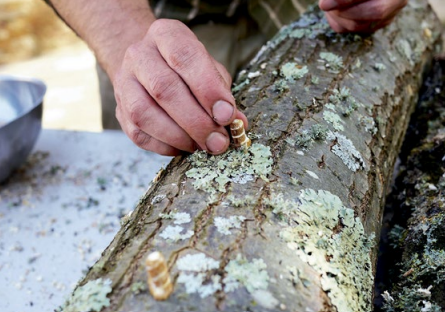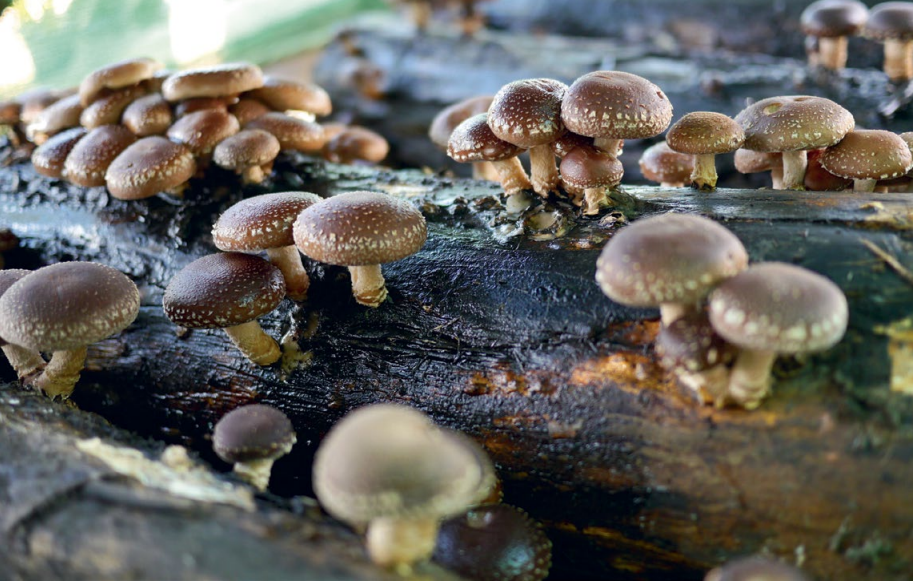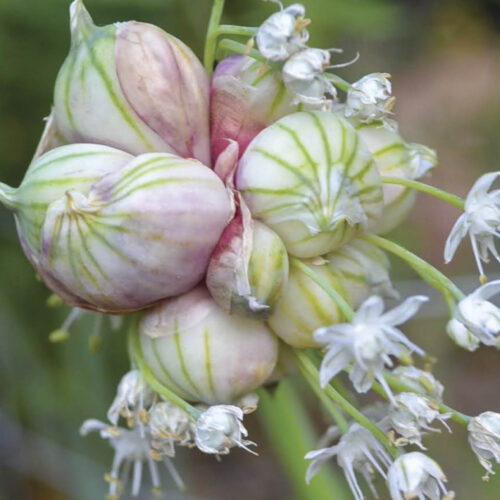Grow your own shiitake mushrooms
2022-03-02T01:46:42+11:00
Kirsten Bradley explains how to produce your own supply of delicious shiitake mushrooms.
The world of fungi extends far beyond the different mushrooms we know and love, whether on our plates or sometimes popping up in our gardens after rain. Fungi exist everywhere – they’re integral to our ecosystems and medicines as well as beer, chocolate and cheese. To say nothing of their important role within us, as part of our microbiome. Without fungi, life on earth might not exist at all.
Fungi are an entirely separate kingdom of life – they’re not a plant, nor an animal. The kingdom of fungi (Eumycota) encompasses yeasts, tinea, penicillium, moulds, blights and mushrooms, to name just a few. Compared to animals and plants, very little is known about this weird and wonderful kingdom of life. It’s estimated there may be up to 6 million species of fungi, although only about 1.5 per cent of those have been formally classified – compare that with the total of 390,000 species of plants on earth! Of all the species of fungi, only about 100,000 of them produce fruiting bodies – the things we know as mushrooms.
These are the macrofungi that start as spores, emitted from a mushroom much like seeds from a seed pod. When a spore lands on a suitable substance, it grows into a thread-like hypha. When two or more compatible hypha grow near each other, they bond together and share their genes to produce mycelium, a large network of hyphae, looking a little like a branching web of delicate white threads or roots. Different mycelium eat different things. Some break down whatever woody substances they can get close to. Some mycelium have special relationships with certain tree species, trading minerals for sugars with plant roots. Some mycelium eat insects, or live within them. They’re truly embedded into every aspect of life on earth, in a whole range of symbiotic roles. When conditions are right, the mycelium of a macrofungi will start to produce fruiting bodies in the form of mushrooms to reproduce and extend its territory.
Types of fungi
Fungi can be divided into two main categories: mycorrhizal and saprotrophic. Mycorrhizal fungi are the type that form partnerships with particular plants, usually certain types of living trees. Many of the common foraged edible mushrooms you’ll find in forests are mycorrhizal – things like saffron milk caps and slippery jacks, which live under, and in concert with, different kinds of living pine trees. Saprotrophic fungi prefer to eat dead and decaying material, and aren’t nearly so fussy about the species they grow on. You’ll find them sprouting from dead tree logs or stumps, or in your compost heap.
Home cultivation
If you’re keen to start mushroom cultivation, begin with saprotrophic fungi – specifically, delicious edible ones that produce mushrooms easily on straw or logs. Of course, once you’ve mastered the process, you can branch out (like a mycelium!) to other mushrooms that have more specific needs.
Cultivating mushrooms is not unlike growing plants. You’re just dealing with a different kingdom of life, which has different life cycles, needs and outputs. Once you understand the basics, you can get creative. Happily, mushroom cultivation can be done inside, outside or wherever you have space, and needs zero special equipment to get started. The two easiest ways to get cultivating are to either buy a bag of oyster mushroom grain spawn and cultivate them in a bucket, or buy shiitake plug spawn and grow shiitake mushrooms on a log or two. Spawn is sold in bags from mushroom suppliers online.
Lentinula edodes (shiitake)
Shiitake are a great species to use for simple outdoor cultivation as they will grow on logs in your garden. Although they’re a lot slower to fruit than oyster mushrooms, if you inoculate a batch of logs every year you can soon have a regular supply of delicious shiitakes. A single inoculated log can flush again and again for up to five years.
The main strain we use fruits between 14 and 20°C (57 and 68°F), which is a wide enough bracket for most cool and warm temperate climates. There are colder and warmer strains that fruit below, and above, that temperature envelope.
Cultivating a shiitake mushroom log
All you need to start is a fresh log, some spawn, a few simple tools and your fine self to put it all together. The basic process is pretty simple. The aim is to insert a small amount of inoculated material, in the form of wooden plugs colonised with shiitake mycelium, into holes that you’ve freshly drilled in the log. The plug makes contact with the sapwood, which is the top layer of material, just underneath the bark. The mycelium in the plug will then enthusiastically begin to colonise and eat the sapwood.
Sourcing spawn and logs
Shiitake spawn, in the form of plugs or dowels, are readily available online from a reputable mushroom spawn supplier. Shiitake are native to East Asia and grow naturally in decomposing hardwood logs and stumps.
In Australia, shiitake have been successfully grown on oak, smooth-barked eucalypts, or on any other hardwoods that are fast-growing, have lots of sapwood and that hold their bark once they’re dead (though yields will vary according to the log species). Avoid species that are known for their in-ground durability like box, ironbark or turpentine.
Look for logs that are:
- cut from a live tree (to avoid contamination);
- about a metre in length and about 10–20cm in diameter;
- consistent in size (so they stack well);
- not too heavy (so they are safe to handle).
If you’re not sure where to source logs, call a local arborist, rural fencing contractor or your local council’s green waste crew – they’re often helpful. Logs can often be sourced for firewood prices or even free in some cases. Dowel spawn (plug spawn) should cost around $70 per 1000, enough to inoculate 40 to 50 logs. With an expected harvest of at least 1kg of mushrooms per log you can grow over $2000 worth of gourmet mushrooms for a $200 outlay, a few hours of your time and some patience.
Drilling and inoculating
For plug spawn, the aim is to drill a hole that’s just a teeny bit wider than the plug size you have, and a little deeper than the plug is long. For plug spawn this is usually a hole 8.5mm in diameter and about 30mm deep.
The holes should be no more than 15cm apart, dotted all along and around the length of the log – the more inoculation points, the more effective the colonisation of the log by your mycelium and the more mushrooms!
Hammer your plug spawn into the holes using a rubber mallet until the plugs are flush or sitting just below the surface. Seal over the inoculation points with melted beeswax or paraffin wax, painted on with a paintbrush, or small sponge. Sealing the holes ensures the shiitake mycelium have a big head start on any other fungi that may want to colonise your log. The picture below shows the plugs being put into drilled holes (credit: Milkwood).

Siting and fruiting
There’s a bit of waiting in the shiitake log game. Traditionally, they are stacked in pine forests – somewhere that’s shady, cool and moist, but with good airflow. In lieu of a forest, find somewhere at least shady and moist. Shiitake logs do best with 25mm of rain or overhead watering every week. Using a hose, you can give your logs a water for about one minute each time. Watering with town water is fine, and rainwater is even better.
After as little as six months (but up to as long as 18 months), the white rot of the mushroom mycelium will soften the area directly around the inoculation points. Once this area is the size of a chicken’s egg, your logs will be ready to fruit. They will naturally fruit when the log is fully colonised and the weather cools or becomes more moist.
You can also ‘shock’ your logs in order to get better, stronger flushes of mushrooms. Soak them overnight in clean water – a bath works well for this. In the morning remove your logs from the water and give them a solid whack with a hammer or drop them on a concrete slab (physical shocks cause shiitake to fruit more intensely). Then stack the logs with some space between each in a moist but open location (not tightly this time) and check daily for mushrooms. Harvest, and enjoy.

As mentioned, you can get up to five years of flushes from each log in the right environment, so spending time figuring out where the ‘shiitake sweet spot’ is at your place is very worthwhile. Happy cultivating!
Learn more
Milkwood: Real skills for down-to-earth living – this book has an entire chapter on mushroom cultivation for Australian readers; milkwood.net/book
Radical Mycology: A treatise on seeing & working with fungi by Peter McCoy
fungimap.org.au – a citizen science project that’s great for identifying native fungi that you may find
For spawn, search online for ‘shiitake plug spawn’ – suppliers include: aussimushroomsupplies.com
miltonmushrooms.com.au
forestfungi.com.au
Foraging for mushrooms is another popular way to get fungi into your kitchen. You need to take care, though – you’ll find more information here.
This article was first published in the magazine: Issue 107 in March/April 2019.






